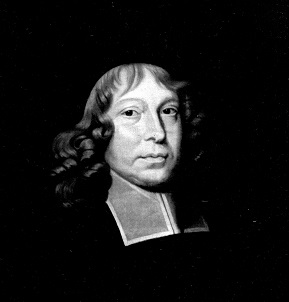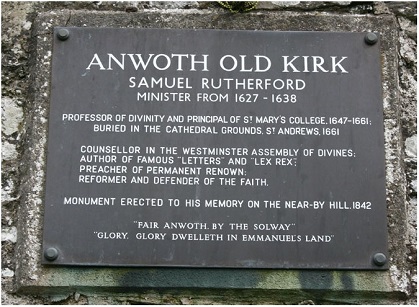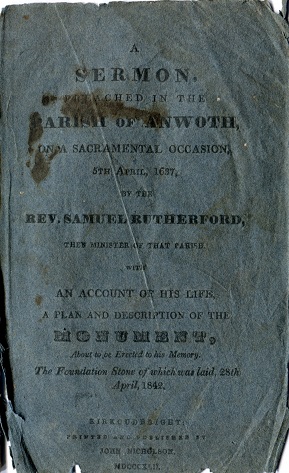Page last updated on: Wednesday, 25 April, 2018.
|
|
|
BORN : 1600 Nesbit, Roxburghshire (now part of Crailing Parish and 4 miles from Jedburgh).
Father: believed to be John Rutherford, fairly well-to-do farmer (1570-1630)
Mother: believed to be Margaret Jane Gibson (1576-1640)
No birth documents exist, but descendant families and other relatives have stories which they tell on Ancestry.co.uk
Mother lived at Anwoth with Samuel and his 1st wife. Mother died at Anwoth in 1635.
SIBLINGS : 2 brothers:
Rev George Rutherford, born 1602. Was later a schoolmaster in Kirkcudbright.
Captain James Rutherford, born 1605, an officer in the Dutch Army and a 'residenter in Utrecht', who died in 1668.
Will of 1668 mentions nieces Barbara (George's daughter) and Agnes (Samuel's surviving daughter).
EDUCATION :
Samuel was educated at what later became Jedburgh Grammar School & then Edinburgh University (from where he graduated in1621).
MARRIAGES :
-
Euphame (or Euphamia) Hamilton.
Samuel was a Professor of Humanities and a Latin Tutor at Edinburgh University when he met Euphame. He was forced to resign this position and he was reprimanded for his 'affair' with her. The couple are believed to have married in 1626 but we have no evidence for this.
It is reported that the rebuke he received for improper relations with Euphame was a principal cause for Samuel taking up divinity.
Euphame died in June 1630 (possibly at Anwoth), after a long painful illness.
-
Jean McMath, 24th March 1640 to (Jeane Mackmath ex Edinburgh Register of Marriages, 1595 - 1700).
She was possibly the daughter of an Edinburgh merchant and the widow of Hugh Montgomery of Batharie, Co. Down, Ireland. Some sources give marriage place as St Andrew & St Leonards, Fife on 1st March 1640 but this is probably the reading of the banns.
CHILDREN : (Note dates of birth seem to vary depending on source)
Samuel & Euphame:
Marie (W.) Rutherford - Christened Marie Rutherfoorde on 14th April 1626 - father Samuel Rutherfoorde, mother Euphame Hammilton in Edinburgh Parish. (ex IGI).
Marie died young.
Some sources suggest that Samuel & Euphame may have had another daughter Agnes around 1626 and maybe later they had another child, both of whom died young.
Samuel & Jean: All registered to Samuel and Jean at St Andrews & St Leonards, St Andrews, Fife.
(ex Scotlands People Index of births).Katherin Rutherfurde - 25th February 1641
Johne Rutherfurde - 27th June 1642
Robert Rutherfurde 31st July 1643
Jeane Rutherfurde - 17th August 1645
Agnes Rutherfuird- 20th May 1649 - [Agnes married William Chiesly W.S. of Cockburn in 1674.
Died in 1694 (ex Find a Grave website)]
Samuell Rutherfuird - 2nd March 1651
Margret Rutherfuird - 18th March 1655
Six of his seven children pre-deceased him - 2 died before he and Jean went to London in 1643, and 2 died while they were in London between 1643 and 1647. Only Agnes lived to be an adult.
DEATH
Samuel died: 20th March 1661 possibly in St Andrews.
(Some sources say 29th March but grave says 20th. Some sources say he died in London).
Gravestone in St Regulus Chapelyard, St Andrews, Fife.
Monument on Boreland Hills, Gatehouse of Fleet, Kirkcudbrightshire.
Mrs Jean Rutherford died 16th May 1675 (Edinburgh ?). She was buried in Greyfriars Churchyard, Edinburgh.
(Register of Burials 1658-1700, Canongate, Edinburgh ex Ancestry)
CAREER:
1623 - Professor of Latin at Edinburgh University. (Regent of Humanities).
1627 - Appointed minister at Anwoth Church.
1636 - During the Reformation, and by the mid-16th century, Protestantism replaced Catholicism as the main religion in Scotland. In the reformed churches there were many who preferred the more simple form of Presbyterianism were elders were elected to run their churches. This was in contrast to the Episcopalian form which were run by bishops and which was favoured by the King and state. Rutherford was a strong supporter of Presbyterianism and made his feelings clear in his sermons and writings. This brought him into conflict with the authorities and led to a ban on him preaching and he was exiled to Aberdeen, maybe for up to 2 years. During his exile Rutherford wrote over 200 letters to his Anwoth parishioners and other supporters in order to keep getting his opinions heard..
1638 - over 300,000 Scots signed the National Covenant which declared Presbyterianism as the national church (the Kirk) of Scotland and independent from the king and the state. Rutherford managed to leave Aberdeen and return to Anwoth. However later that year the ruling body of the Kirk (the General Assembly) appointed him to the position of Professor of Divinity at St Andrews University, a post he accepted reluctantly.
1643 - 1647 In London with wife Jean and one surviving child. Samuel was one of the four Commissioners of Church of Scotland to the Westminster Assembly.
While in London, Rutherford wrote his best-known work, "Lex Rex," or "The Law, the King." This book argued for limited government, and limitations on the idea of the Divine Right of Kings, which was a popular belief at the time.
1651 - Returned to St Andrews as Rector of St. Mary's College.
1660 - Summoned to appear before Parliament on a charge of treason because of his religious writings. He died before he was able to attend.
A Google search will access many of his sermons, writings, letters and other information.
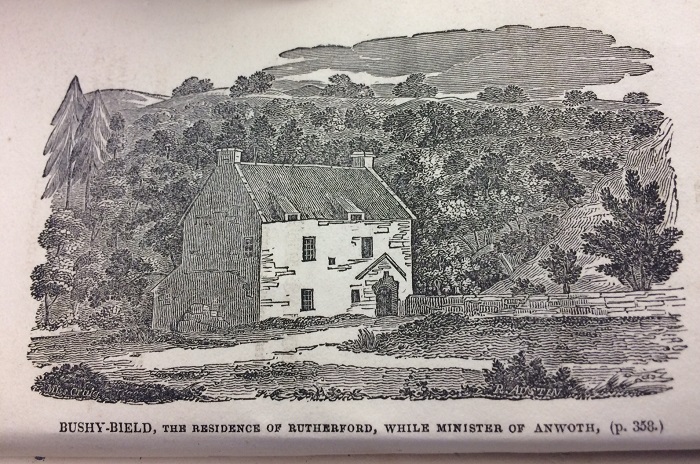
This sketch of Bushy Bield is taken from the publication "The Life of Samuel Rutherford" by Thomas Murray
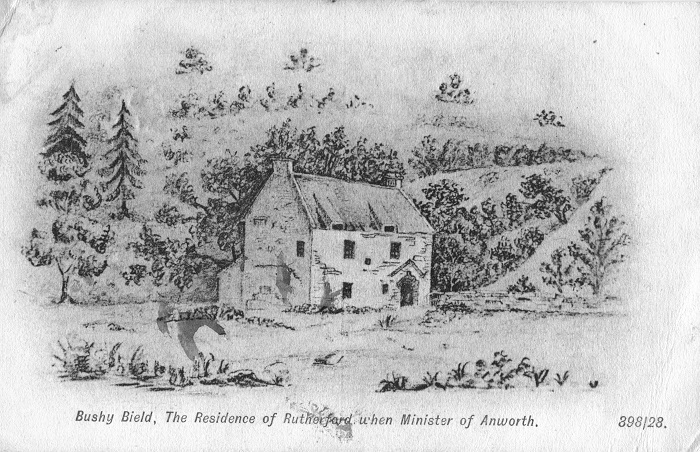
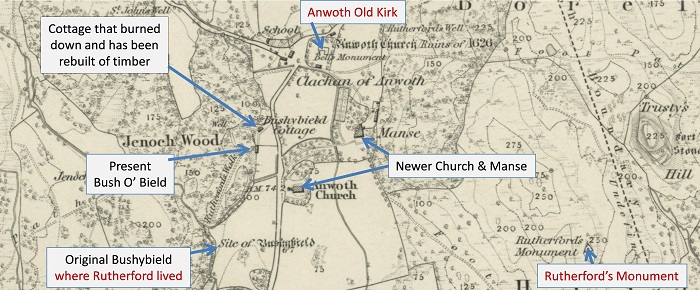
This map shows the location of the "old" and the "new" Bushy Bield as well as the Rutherford Monument.
Rutherford's Monument : Boreland Hills, Anwoth
1627 – 1638 Samuel Rutherford was Minister of Anwoth.
1830's - public subscriptions collected to build a monument in memory of Rutherford.
1842 - 28th April : foundation stone for Rutherford's Monument laid in a prominent position on Boreland Hills
with views over Gatehouse of Fleet, the River Fleet estuary and towards Anwoth Church.
Monument probably completed later the same year.
It cost over £200 and was built by J & J Stewart, builders and architects from Gatehouse. (In the 1841 Anwoth census, John Stewart was a 45 year old architect & builder. In the 1915 obituary for his daughter Isabella Tait, her father John Stewart is named as the builder of the first monument.)
It was not universally liked, being described as 'squat and stunted' in letter to the Dumfriesshire & Galloway Standard & Advertiser in 1850. Nevertheless shipping in the Fleet estuary found it a useful guide. Presumably it was built without an adequate lightening conductor.
1847 - In May the monument was struck by lightning. Newspaper reports state that blocks of stone were thrown up to 50
yards away. One side was completely destroyed while the other was scarred and blackened and almost every stone
loosened.
The inscription stone was still intact but had been displaced.
1851 - Rutherford Monument rebuilt - again after public donations.
The builder was Robert Hume from Gatehouse.
(In the 1851 Anwoth census, he was a master builder employing 11 men.)
It is likely that this was a new design and it might have been in a different location.
2000 - To commemorate the new Millennium, a new monument was built on a nearby hill to commemorate all the ministers
who had served the parishes of Girthon and Anwoth.
2016 – Rutherford’s Monument is in a precarious state and needs a major repair.
|
|
Shown on the left is the front cover of a damaged old booklet which, it appears,was produced to help raise funds for the 1st re-building of the Rutherford Monument in the early 1840s. It contains 3 basic parts :- 1. A plan drawing of the monument together with some text which describes the laying of the foundation stone. 2. An 8-page memoir about the life of Samuel Rutherford. 3. A 21-page transcript of a sermon that Samuel Rutherford is said to have made in 1637. We have scanned each page and copied them into one of 3 sections which are presented as downloadable .pdf files. Some time one or all of them may be transcribed so they can be searched electronically. |

